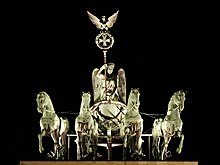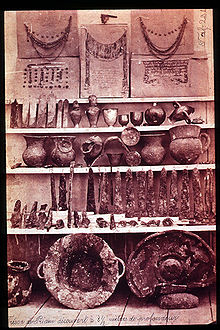Looted art
Looted art is collectively called cultural goods that someone illegally appropriates during a war or a war- like situation (contrary to Art. 56 of the Hague Land Warfare Code ) ( art theft ). This is usually done in order to enrich oneself, one's own party or one's own state ; sometimes to humiliate the enemy. Often the theft of art is also an expression of state ideology .
In jurisprudence , the concept of looted art is differentiated from looted art . By looted art, lawyers understand the loss of culture resulting from the fact that the Nazi regime persecuted art collectors - i.e. private individuals -, blackmailed them, robbed them of their property and in many cases murdered them. Looted art is a cultural phenomenon that has always existed as a result of wars.



Examples in history
- Equipment of St. Mark's Basilica in Venice as booty from the fourth crusade from Byzantium, including 2600 (mostly antique) columns, and above all the so-called " horses of San Marco ".
- An example of art looted the time of the Wars of the Roses is from the Peter von Danzig as Prisengut to Gdansk placed altar by Hans Memling .
- Shortly before the end of the Thirty Years' War , almost all of the treasures of the Hradschin and other palaces on Prague Castle Hill , including 700 paintings, were looted by the Swedish army under General Königsmarck in the Prague art theft in 1648 and transferred to Sweden on the orders of Queen Christina .
- On his campaigns, Napoléon Bonaparte took possession of numerous valuable works of art for France, which were reclaimed by the Allies after the end of the Empire in 1814 (see Chaptal Decree ).
- Transfer of the peacock throne to Persia in 1739.
- The Emerald Buddha was stolen several times by Laotian principalities from one another and most recently from Vientiane in 1778 by Rama I , King of Thailand. The ruling Chakri dynasty refuses to grant restitution to this day.
- The so-called cultural goods dispute between Zurich and St. Gallen was caused by the Toggenburg War (April 12 to August 17, 1712) and was settled in April 2006.
- Nazi-looted art : The National Socialists acquired many important works of art through looted and expropriated in their territory.
- Looted art of the Allies : The Allies, especially the Soviet Union and Poland, but also the Western Allies took possession of German cultural assets after the defeat of the German Reich. Most of the art objects were returned by the Western Allies, as far as they could still be found. In the successor states of the Soviet Union and in Eastern Europe there are still extensive art holdings and holdings from German libraries. Often these are not accessible to the public. One of the most famous examples of this type of looted art is Priam's treasure (now in Moscow).
See also
- Hague Convention for the Protection of Cultural Property in the Event of Armed Conflict
- Looted art
- Looted Art (Second World War)
- Restitution of looted art
- Restitution (Austria) (the return or reparation process in Austria)
- Washington Declaration
- Provenance research
- Reich exchange office
literature
- Bénédicte Savoy: Art theft. Napoleon's Confiscations in Germany and the European Consequences. Böhlau Verlag, Cologne / Weimar / Vienna 2010, ISBN 978-3-205-78427-2 . (Translation by Bénédicte Savoy: Patrimoine annexé. Les biens culturels saisis par la France en Allemagne autour de 1800. Editions de la Maison des sciences de l'homme, Paris 2003, ISBN 978-2-7351-0988-3 ).
- Hector Feliciano: The Lost Museum. About art theft by the Nazis. Translated from English by Chris Hirte. Aufbau-Verlag, Berlin 1998, ISBN 3-351-02475-4 .
- Gilbert H. Gornig: Protection of cultural goods - international and national aspects. Duncker & Humblot, Berlin 2007, ISBN 978-3-428-12525-8 , ( Constitutional and international law treatises of the study group for politics and international law 24).
- Waldemar Ritter: cultural heritage as spoil? The repatriation due to the war from Germany verbrachter cultural assets - the need and opportunities for the solution of a historic problem (Scientific Beibände to the indicator of the Germanic National Museum Volume 13) , published by the Germanisches Nationalmuseum, Nuremberg 1997, ISBN 3-926982-49-7 .
Web links
- International Convention of July 29, 1899 on the Laws and Customs of War on Land (with regulations) Art. 56
- International symposium "Trophy-Loss-Equivalents" (Moscow) on dealing with looted art from the Second World War, report by Robert Baag on Deutschlandfunk DLF Saturday, February 28, 2009, Kultur heute, 5.30pm-6pm
- Special exhibition “Robbery and Restitution. Cultural assets from Jewish property from 1933 to the present day ”, Jewish Museum Frankfurt am Main, April 23 - August 2, 2009